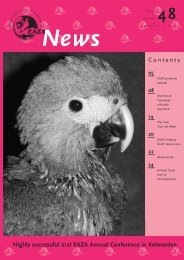EAZA News 58-9 - European Association of Zoos and Aquaria
EAZA News 58-9 - European Association of Zoos and Aquaria
EAZA News 58-9 - European Association of Zoos and Aquaria
Create successful ePaper yourself
Turn your PDF publications into a flip-book with our unique Google optimized e-Paper software.
presently maintained in a large outdoor enclosure at the university.<br />
During the past five years the research project at the university has<br />
housed 17 pacaranas (including some young born) <strong>and</strong> five mountain<br />
pacas. Even though births have occurred throughout the time, many<br />
newborns died during the first days <strong>of</strong> life <strong>and</strong> an increased mortality in<br />
adults reduced the population to eight animals.<br />
Support from NGO’s <strong>and</strong> zoos<br />
The project has been supported mainly by UDCA, with additional funding<br />
obtained for specific research from national <strong>and</strong> international NGO’s. The<br />
<strong>EAZA</strong> Small Mammal TAG recommended that a consortium <strong>of</strong> zoos should<br />
be formed to support this work. Consequently, since 2004, with the advice<br />
<strong>of</strong> the Society for the Protection <strong>of</strong> Species <strong>and</strong> Populations (ZGAP), a<br />
Memor<strong>and</strong>um <strong>of</strong> Agreement was signed.<br />
The Pacarana Conservation Programme is supported by Newquay Zoo, Poznan<br />
Zoo, Chester Zoo <strong>and</strong> non-<strong>EAZA</strong> member Tierpark Cottbus. Recently, the<br />
Los Angeles Zoo has also joined the Pacarana Conservation Committee. The<br />
financial <strong>and</strong> advisory support from zoos will allow increased veterinary care<br />
<strong>and</strong> building <strong>of</strong> a new facility, designed according to the international st<strong>and</strong>ards<br />
<strong>of</strong> ex situ conservation programmes. This new facility is a priority to guarantee<br />
a better quality <strong>of</strong> life for the animals maintained in captivity at the UDCA.<br />
Long-term actions<br />
Successful in situ <strong>and</strong> ex situ conservation to assist wild populations<br />
requires education, support <strong>of</strong> field conservation initiatives, research,<br />
<strong>and</strong> maintaining or preserving significant amounts <strong>of</strong> genetic variation<br />
for the future. Pilot wildlife management programmes will be important<br />
for raising public awareness <strong>and</strong> support for wildlife management <strong>and</strong><br />
conservation in general. Colombians, like people elsewhere, are more<br />
likely to support conservation programmes that <strong>of</strong>fer them tangible<br />
incentives instead <strong>of</strong> legal prohibitions. The Pacarana Conservation<br />
Programme Committee has outlined a global research plan with specific<br />
in situ <strong>and</strong> ex situ projects. These will include:<br />
– DNA studies to define genetic <strong>and</strong> demographic variability at the<br />
captive breeding colony <strong>and</strong> in remaining wild populations;<br />
– definition <strong>of</strong> the real conservation status <strong>of</strong> the species in Colombia;<br />
– evaluation <strong>of</strong> the communities’ attitude towards the species;<br />
– evaluation <strong>of</strong> the remnant tropical mountain forest;<br />
– continuation <strong>of</strong> general biological <strong>and</strong> ecological studies <strong>of</strong> the species.<br />
Facility relocation<br />
During January 2006, Stewart Muir <strong>of</strong> Newquay Zoo visited the UDCA<br />
to see the facility in which the pacarana are kept <strong>and</strong> to help advise on<br />
a possible course <strong>of</strong> action. Initially, the funding provided by the <strong>European</strong><br />
zoos was to improve the existing facility <strong>and</strong> tackle the serious problem <strong>of</strong><br />
rat infestation. However, the many problems <strong>of</strong> keeping the animals on<br />
their present site have become apparent. Its close proximity to domestic<br />
livestock, the rat problem <strong>and</strong> the lack <strong>of</strong> possibility for expansion led to<br />
the idea <strong>of</strong> relocating the facility to another part <strong>of</strong> the campus. Although<br />
this would cost more money than originally planned it was agreed that<br />
this was the best solution.<br />
conservation<br />
Approximately 500,000 larvae transported in plastic bottles photo stewart muir/newquay zoo<br />
Thanks to the donation <strong>of</strong> rat poison from ZGAP, the rat problem has been<br />
greatly reduced during the last year. Final architectural drawings <strong>of</strong> the<br />
new facility, including enclosures, a research room, a kitchen <strong>and</strong> an <strong>of</strong>fice<br />
have been approved <strong>and</strong> planning permission has been granted for a new<br />
site. Construction is due to start in the very near future, <strong>and</strong> it is hoped<br />
that the pacaranas will all soon be moving to their new home.<br />
Future support<br />
The priority <strong>of</strong> the Pacarana Conservation Committee is the welfare <strong>of</strong><br />
the pacarana breeding colony at UDCA. Until now, research is carried out<br />
mainly supported by funds. Long-term actions will be supported by zoos<br />
which will carry out in situ <strong>and</strong> ex situ research. Consequently, the<br />
Pacarana Conservation Programme requires more funding <strong>and</strong>, in future,<br />
more research expertise. Besides this, expertise in enclosure design is<br />
needed; a breeding enclosure has to be established at a nature reserve<br />
area which will need a building license from local environmental<br />
authorities.<br />
Institutions interested in funding opportunities or other supporting<br />
measures, please contact Karin Osbahr at kosbahr@udca.edu.co •<br />
Reference: Mohr, E., 1937. Vom Pacarana Dinomys branickii (Peters).<br />
Der Zoologische Garten NF9, 204-209.<br />
Approximately 500,000 larvae transported in plastic bottles photo karin osbahr/udca<br />
This article has been abridged <strong>and</strong> the references were left out due to space limitations. For the original full version <strong>of</strong> the article including reference details, please refer to the ‘Magazine’ section <strong>of</strong> the <strong>EAZA</strong> website.<br />
eaza news <strong>58</strong><br />
2007<br />
27

















